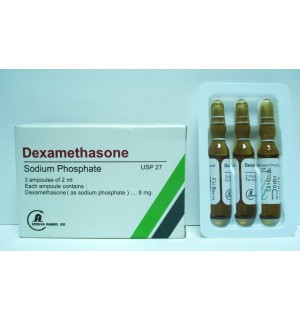
Dexamethasone
Ampoules
Composition:
Each ampoule (2 ml) contains:
Dexamethasone sodium phosphate (equivalent to 8 mg Dexamethasone).
Properties and Mechanism of Action:
Dexamethasone is a synthetic corticosteroid which has a rapid onset and short
duration of action so it is suitable for the treatment of acute disorders responsive
to corticosteroid therapy.
Dexamethasone has less sodium and water retaining property than
hydrocortisone and other related derivatives.
Dexamethasone has very high glucocorticoid activity in conjunction with
insignificant mineralocorticoid activity. This makes it particularly suitable for
high-dose therapy in conditions where fluid retention would be a disadvantage.
Indications and Usage:
By intravenous or intramuscular injection:
Endocrine disorders as in cases of :
– Primary or secondary adrenocortical insufficiency.
– Acute adrenocortical insufficienc .
– reoperatively, and in the event of serious trauma or illness, In patients with known adrenal insufficiency or when adrenocortical reserve is doubtful.
– Shock unresponsive to conventional therapy if adrenocortical insufficiency
exists or is suspected .
– Congenital adrenal hyperplasia.
– Nonsuppurative thyroiditis.
– Hypercalcemia associated with cancer.
Rheumatic disorders
As adjunctive therapy for short-term administration in:
– Post-traumatic osteoarthritis .
– Synovitis of osteoarthritis .
– Rheumatoid arthritis, including juvenile rheumatoid arthritis (selected cases may require low-dose maintenance therapy) .
– Acute and subacute bursitis.
– Epicondylitis.
– Acute nonspecific tenosynovitis.
– Acute gouty arthritis .
– Psoriatic arthritis.
– Ankylosing spondylitis.
Collagen diseases
During an exacerbation or as maintenance therapy in selected cases of:
– Systemic lupus erythematosus.
– Acute rheumatic carditis.
Dermatologic diseases
– Pemphigus.
– Severe erythema multiforme (Stevens-Johnson syndrome).
– Exfoliative dermatitis.
– Bullous dermatitis herpetiformis.
– Severe seborrheic dermatitis.
– Severe psoriasis.
– Mycosis fungoides.
Allergic states
Control of severe or incapacitating allergic conditions intractable to
adequate trials of conventional treatment in:
– Bronchial asthma.
– Contact dermatitis.
– Atopic dermatitis.
– Serum sickness .
– Seasonal or perennial allergic rhinitis.
– Drug hypersensitivity reactions.
– Urticarial transfusion reactions.
– Acute noninfectious laryngeal edema (epinephrine is the drug of first
choice).
Cerebral Edema associated with primary or metastatic brain tumor,
craniotomy, or head injury .
By intra-articular or soft tissue injection:
As adjunctive therapy for short-term administration in:
– Synovitis of osteoarthritis .
– Rheumatoid arthritis.
– Acute and subacute bursitis.
– Acute gouty arthritis.
– Epicondylitis.
– Acute nonspecific tenosynovitis.
– Post-traumatic osteoarthritis.
By intralesional injection:
– Keloids.
– Localized hypertrophic, infiltrated, inflammatory lesions of: lichen planus,
psoriatic plaques, granuloma annulare, and lichen simplex chronicus (neurodermatitis)
– Discoid lupus erythematosus .
– Necrobiosis lipoidica diabeticorum .
– Alopecia areata .
– Cystic tumors of an aponeurosis or tendon (ganglia).
Contraindications:
Dexamethasone is contraindicated in:
– Hypersensitivity to any component of the product .
– Systemic fungal infections.
Warnings:
Pregnancy:
Use of Dexamethasone in pregnancy or in women of childbearing potential
requires that the anticipated benefits be weighed against the possible hazards to the mother and embryo or fetus.
Nursing Mothers:
Mothers taking pharmacologic doses of corticosteroids should be advised
not to nurse.
Therapy with corticosteroids should be used with great caution after a recent myocardial infarction .
Precautions:
– Corticosteroids should be used cautiously in patients with ocular herpes
simplex for fear of corneal perforation.
– Aspirin should be used cautiously in conjunction with corticosteroids in
hypoprothrombinemia . Prothrombin time should be checked frequently in
patients who are receiving corticosteroids and anticoagulants at the same time.
– Phenytoin, phenobarbital, ephedrine, and rifampin may enhance the
metabolic clearance of corticosteroids resulting in decreased blood levels
and physiological activity, thus adjustment in corticosteroid dosage is required.
– When corticosteroids are administered concomitantly with potassium-
depleting diuretics, patients should be observed closely for development
of hypokalernia.
– Pediatric Use
Growth and development of pediatric patients on prolonged corticosteroid
therapy should be carefully followed.
Side Effects:
– Fluid and electrolyte disturbances
Congestive heart failure in susceptible patients, potassium loss, hypokalemic
alkalosis, hypertension.
– Musculoskeletal
Osteoporosis ( long term use) .
– Gastrointestinal
Peptic ulcer with possible subsequent perforation and hemorrhage , perforation of the small and large bowe, particulady in patients with inflammatory bowel disease, pancreatitis, abdominal distention, ulcerative
esophagitis
– Dermatologic
Impaired wound healing, erythema, increased sweating.
– Endocrine
Menstrual irregularities, manifestations of latent diabetes mellitus , increased
requirements for insulin or oral hypoglycemic agents in diabetics.
– Ophthalmic
Increased intraocular pressure, glaucoma.
– Other
Anaphylactoid or hypersensitivity reactions, thromboembolism, weight gain, increased appetite.
Dosage and Administration:
For intravenous, intramuscular, intra-articular, intralesional, and soft tissue
injection.
* Intravenous and Intramuscular Injection
The initial dosage of Dexamethasone varies from 0.5 to 9 mg a day depending on the disease being treated. In less severe diseases doses lower than 0.5 mg may suffice, while in severe diseases doses higher than 9 mg may be required.
* Cerebral Edema
Dexamethasone is generally administered initially in a dosage of 10 mg intravenously followed by 4 mg every six hours intramuscularly until the symptoms of cerebral edema subside. Response is usually noted within 12 to 24 hours and dosage may be reduced after two to four days and gradually discontinued over a period of five to seven days.
* Acute Allergic Disorders
1 or 2 ml (4 or 8 mg) of Dexamethasone intramuscularly .
* Intra-articular, Intralesional, and Soft Tissue Injection
Intra-articular, intralesional, and soft tissue injections are generally employed
when the affected joints or areas are limited to one or two sites. Dosage and frequency of injection varies depending on the condition and the site of injection. The usual dose of Dexamethasone is from 0.2 to 6 mg. The frequency usually ranges from once every three to five days to once every two to three weeks.
How supplied :
A box containing three ampoules ( 2 ml ) .
A box containing five ampoules ( 2 ml ) .
Produced by:
Sigma-Tec Pharmaceutical Industries- Egypt- S.A.E.
